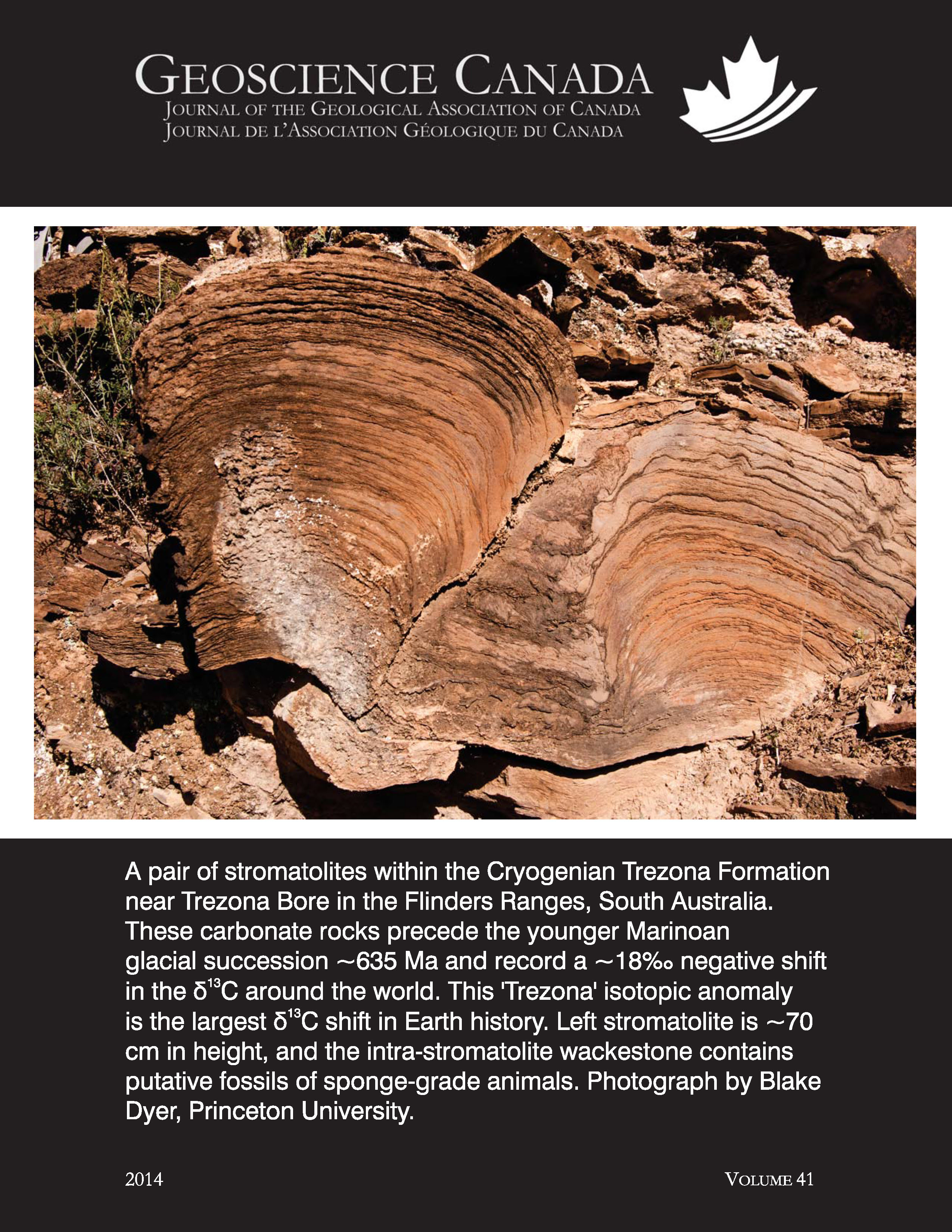Harold Williams Series
Crustal Evolution of the Northeast Laurentian Margin and the Peri-Gondwanan Microcontinent Ganderia Prior to and During Closure of the Iapetus Ocean: Detrital Zircon U–Pb and Hf Isotope Evidence from Newfoundland
Publié-e 2014-08-29
Comment citer
Willner, A. P., Gerdes, A., Massonne, H.-J., van Staal, C. R., & Zagorevski, A. (2014). Crustal Evolution of the Northeast Laurentian Margin and the Peri-Gondwanan Microcontinent Ganderia Prior to and During Closure of the Iapetus Ocean: Detrital Zircon U–Pb and Hf Isotope Evidence from Newfoundland. Geoscience Canada, 41(3), 345–364. https://doi.org/10.12789/geocanj.2014.41.046
Résumé
Detrital zircon populations in sedimentary rocks from the Laurentian margin and the accreted microcontinent Ganderia on both sides of the main Iapetus suture (Red Indian Line) in central Newfoundland have been studied by combined U–Pb and Lu–Hf isotope analyses. Variation in εHf(t) values with age of zircon populations of distal provenance (>900 Ma) reflect the crustal evolution within the source continents: in zircon derived from Laurentia, episodes of juvenile magma production in the source could be detected at 1.00 – 1.65 and 2.55 – 3.00 Ga, and mixing of juvenile and recycled crust in continental magmatic arcs occurred at 0.95 – 1.40, 1.45 – 1.60, 1.65 – 2.05 and 2.55 – 2.75 Ga. These ages are consistent with the crustal history of northeastern Laurentia. Similarly, zircon of distal provenance from Ganderia reveals times of juvenile magma production in the source at 0.70 – 0.90, 1.40 – 1.75, 1.85 – 2.40 and 2.7 – 3.5 Ga, and episodes of mixing juvenile and recycled crust at 0.95 – 1.35, 1.45 – 1.60, 1.70 – 2.15 and 2.6 – 2.8 Ga. These data reflect the crustal evolution in the present northern part of Amazonia, its likely source craton.The evolution of magmatic arcs at the margins of both continents can be studied in a similar way using detrital zircon having a proximal provenance (<900 Ma). In contrast to the Laurentian margin, Ganderia is characterized by development of Neoproterozoic – Cambrian continental arcs (ca. 500 – 670 Ma) that were built on the margin of Gondwana. εHf(t) values indicate recycling of Neo- and Mesoproterozoic crust. During and following accretion of the various elements of Ganderia to Laurentia, the syn-tectonic Late Ordovician to Silurian sedimentary rocks deposited on the upper plate (composite Laurentia) continued showing only detritus derived from Laurentia. These sedimentary rocks contain detrital zircon from Iapetan juvenile, continental and successor arcs that were active between ca. 440 and 550 Ma, and from continuing magmatic activity until 423 Ma. Arrival of the first Laurentian detritus at the outermost part of Ganderia indicates that the Iapetus ocean was closed at ca. 452 Ma. The magmatic arcs along the former Laurentian margin in Newfoundland evolved differently. In the northwestern part, εHf(t) values point to recycling of Mesoproterozoic and Paleoproterozoic crust. In the southwest, εHf(t) values indicate addition of juvenile crust, recycling of Mesoproterozoic crust and mixing with juvenile magma.
SOMMAIRE
Les populations de zircons détritiques des roches sédimentaires issus de la marge laurentienne et du microcontinent d’accrétion de Ganderia, des deux côtés de la principale suture Iapetus (linéation de Red Indian) dans le centre de Terre-Neuve, ont été étudiés par analyses combinées U–Pb et Lu–Hf. Les variations des valeurs εHf(t) en fonction de l’âge des populations de zircons distaux (>900 Ma) reflètent l’évolution de la croûte des continents sources : les zircons de Laurentie ont permis de détecter des épisodes magmatiques juvéniles dans la source entre 1,00 - 1,5, et 2,55 - 3,00 Ga, ainsi que des épisodes de mélange de croûte juvénile avec des croûtes d’arcs magmatiques continentaux recyclés entre 0,95 – 1,40, 1,45 – 1,60, 1,65 – 2,05, et 2,55 – 2,75 Ga. Ces datations correspondent bien à l’histoire de la croûte de la portion nord-est de la Laurentie. De même, le zircon distal de Ganderia révèle des épisodes de production de magmas juvéniles dans la source entre 0,70 - 0,90, 1,40 - 1,75, 1,85 - 2,40, et 2,7 - 3,5 Ga, ainsi que des épisodes de mélanges de matériaux juvéniles et de croûtes recyclés entre 0,95 - 1,35, 1,45 - 1,60, 1,70 - 2,15, et 2,6 - 2,8 Ga. Ces données reflètent l’évolution de la croûte dans la portion nord actuelle de l’Amazonie, son craton source probable.
L’évolution des arcs magmatiques à la marge de ces deux continents peuvent être étudiées de la même manière en utilisant le zircon détritique proximal (<900 Ma). Contrairement à la marge laurentienne, celle de Ganderia est caractérisée par le développement d’arcs continentaux Néoprotéozoïque-Cambrien (env. 500 – 670 Ma) qui se sont constitués à la marge du Gondvana. Les valeurs de εHf(t) indiquent un recyclage de la croûte au Néoprotérozoïque et au Mésoprotérozoïque. Durant et après l’accrétion des divers éléments de Ganderia et de la Laurentie, les roches sédimentaires syntectoniques de la fin de l’Ordovicien et du Silurien qui se sont déposées sur la portion supérieure de la plaque (Laurentie composite) ne montrent toujours que des débris provenant de la Laurentie. Ces roches sédimentaires renferment des zircons détritiques juvéniles iapétiques, et d’arcs continentaux et d’arcs subséquents, qui ont été actifs entreentre (env. 440 et 550 Ma) et d’une activité magmatique continue jusqu’à 423 Ma. L’apport des premiers débris à la marge extrême de Ganderia indique que l’océan s’est fermée il y a env. 452 Ma. Les arcs magmatiques le long de l'ancienne marge laurentienne à Terre-Neuve ont évolué différemment. Dans la portion nord-ouest, les valeurs de εHf(t) indiquent un recyclage de la croûte au Mésoprotérozoïque et au Paléoprotérozoïque. Dans la portion sud-ouest, les valeurs de εHf(t) indiquent l’ajout d’une croûte juvénile, un recyclage de la croûte mésoprotérozoïque et un mélange avec un magma juvénile.
